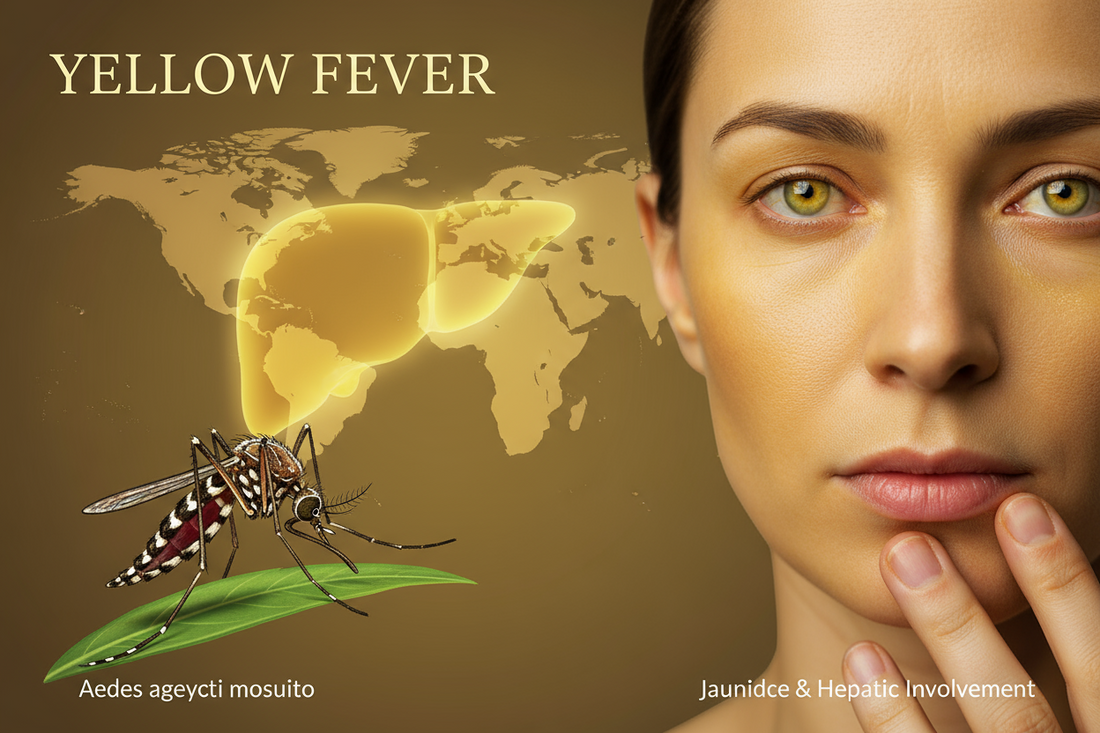
Understanding Yellow Fever: Causes, Symptoms, and Prevention
Share
Yellow Fever is a mosquito-borne viral infection that primarily affects the liver and blood. Though most common in parts of Africa and South America, global travel and climate changes have made awareness of this disease vital for everyone. The name “Yellow Fever” comes from one of its characteristic symptoms — jaundice, which turns the skin and eyes yellow due to liver involvement.
From a modern medical point of view, Yellow Fever is caused by the Yellow Fever virus (YFV), a flavivirus transmitted through the bite of infected Aedes aegypti mosquitoes — the same mosquitoes responsible for dengue and Zika virus.
In Ayurveda, this disease can be correlated with conditions of Pittaj Jwara (fever caused by aggravated Pitta dosha) and Yakrit Dushti (liver imbalance). Ayurveda explains that imbalances in Pitta and Rakta (blood) lead to excessive heat, toxicity, and yellow discoloration of the skin.
This blog will explore the causes, symptoms, complications, and prevention of Yellow Fever from both general medical and Ayurvedic perspectives, while focusing on natural ways to strengthen immunity and support liver health.

1. What Is Yellow Fever?
Yellow Fever is an acute viral hemorrhagic disease transmitted by infected mosquitoes. It has two main phases — an initial acute phase with fever and muscle pain, followed by a toxic phase that can lead to liver and kidney failure. In Ayurveda, Yellow Fever aligns with a Pittaj Jwara where Pitta (the fire element) and Rakta dhatu (blood tissue) are vitiated. This aggravation leads to heat accumulation, yellowish discoloration, and liver inflammation.
Key Ayurvedic principle:
When Pitta increases, it burns the Rasa (nutritive fluids) and Rakta (blood), causing fever, thirst, and yellowish skin — classic features of Yellow Fever.
2. Causes of Yellow Fever
A. General Medical Causes
- Virus: Caused by the Yellow Fever virus, belonging to the Flavivirus family.
- Vector: Spread by the bite of infected Aedes aegypti and Haemagogus mosquitoes.
- Transmission: Mosquito bites an infected person → virus multiplies → mosquito bites another person → infection spreads.
Risk Factors:
- Living or traveling in tropical or subtropical regions
- Lack of mosquito control
- Unvaccinated individuals in endemic areas
B. Ayurvedic Explanation
In Ayurveda, external heat and toxins (Ama) entering the body through air, water, or bites can disturb the Pitta dosha.
This imbalance weakens Agni (digestive fire), leading to the accumulation of toxins in the Yakrit (liver) and Rakta dhatu (blood).
The result: fever, yellowing of eyes and skin, nausea, fatigue, and bleeding tendency.
3. Symptoms of Yellow Fever
A. Early (Acute) Stage
- Sudden high fever
- Chills and shivering
- Headache
- Muscle pain (especially back and knees)
- Nausea or vomiting
- Loss of appetite
- Weakness and dizziness
B. Toxic Stage (Severe Phase)
In some cases, symptoms worsen after 24–48 hours:
- Jaundice (yellowing of skin and eyes)
- Stomach pain and vomiting
- Fatigue and dehydration
- Bleeding from nose, mouth, or eyes
- Slow heart rate (relative bradycardia)
- Dark or reduced urine (indicating kidney stress)
C. Ayurvedic Perspective
According to Ayurveda, these symptoms arise from Pitta aggravation leading to Rakta Dushti (impure blood) and Yakrit Dushti (liver dysfunction).
Classical Ayurvedic Symptoms:
- Haridra varna (yellow discoloration)
- Daha (burning sensation)
- Jwara (fever)
- Arochaka (loss of taste)
- Trishna (thirst)
- Murchha (fainting tendency)
4. Complications of Yellow Fever
If untreated, severe Yellow Fever can lead to:
- Liver failure
- Kidney dysfunction
- Internal bleeding
- Shock and multi-organ failure
Ayurvedic View:
Untreated Pittaj Jwara can convert into Sannipatik Jwara (fever involving all three doshas), leading to life-threatening conditions. Hence, balancing Pitta dosha and detoxifying the liver and blood are crucial.
5. Diagnosis
A. General Medical Diagnosis
- Blood tests to detect antibodies or viral RNA.
- Liver function tests (LFTs) to assess damage.
- Complete blood count (CBC) for low platelet count or anemia.
B. Ayurvedic Approach
An Ayurvedic practitioner observes the dosha imbalance, pulse (Nadi Pariksha), tongue, eyes, and skin color.
They analyze Pitta aggravation, Ama accumulation, and Rakta Dushti before designing a personalized treatment plan.
6. Ayurvedic Management of Yellow Fever
Ayurveda doesn’t directly refer to “Yellow Fever,” but the condition matches Pittaj Jwara and Kamala (jaundice-like disorders).
The focus is on detoxification, balancing Pitta, and strengthening immunity and liver health.
A. Detoxification (Shodhana Chikitsa)
-
Virechana (Therapeutic Purgation):
Helps remove excess Pitta from the intestines and liver. -
Raktamokshana (Blood Purification):
Purifies the blood and reduces Rakta Dushti. -
Panchakarma Therapies:
Used to clear Ama (toxins) and restore balance to Agni and doshas.
B. Palliative Treatment (Shamana Chikitsa)
- Cooling herbs and formulations to reduce Pitta and heat in the body.
- Hydration therapies with herbal infusions to manage dehydration and thirst.
C. Key Ayurvedic Herbs for Yellow Fever Management
- Guduchi (Tinospora cordifolia): Strengthens immunity and detoxifies the liver.
- Kalmegh (Andrographis paniculata): Excellent for liver cleansing and fever management.
- Bhringraj (Eclipta alba): Supports liver regeneration and purifies blood.
- Triphala: Gentle detoxifier that aids digestion and restores Agni.
- Aloe Vera (Kumari): Cools the body, relieves Pitta, and supports liver function.
- Neem (Azadirachta indica): Blood purifier and antimicrobial.
- Turmeric (Haridra): Reduces inflammation and strengthens immunity.
D. Ayurvedic Dietary Guidelines
- Prefer light, easily digestible food — moong dal soup, rice gruel, vegetable broth.
- Avoid spicy, sour, fried, and heavy foods.
- Include cooling foods like cucumber, pumpkin, and coconut water.
- Drink boiled and cooled water with a few drops of lemon or coriander seeds.
E. Lifestyle Tips
- Take adequate rest during fever.
- Avoid exposure to heat and direct sunlight.
- Maintain personal hygiene to prevent mosquito bites.
- Perform gentle pranayama to calm the body and mind.
7. Ayurvedic Preventive Therapies
A. Rasayana Therapy (Rejuvenation)
Rasayana herbs like Amalaki, Shatavari, and Gokshura rejuvenate tissues, support the liver, and enhance Ojas (vitality).
B. Herbal Decoctions (Kashayam)
Daily intake of Guduchi Kashayam or Neem-Turmeric decoction helps purify the blood and prevent infections.
C. Aromatherapy & Oils
Applying coconut or sandalwood oil on the skin helps cool the body and prevent excessive Pitta aggravation.
8. How Ayurveda Helps in Recovery
Even after recovery from Yellow Fever, fatigue and liver weakness can persist. Ayurveda recommends a rejuvenating phase with:
- Pitta-balancing diet (cool, sweet, light foods)
- Herbal ghee formulations for liver support
- Gentle yoga to improve circulation
- Abhyanga (oil massage) to restore strength
For regular health tips & updates visit Ayushakti’s Social Media Pages:
- Facebook – Ayushakti Ayurved | Facebook
- Instagram – Ayushakti Ayurved (@ayushakti)
- Pinterest – ayushaktiayurveda
Get all the updates about Ayushakti Ayurved on WhatsApp directly. Click here to Join our WhatsApp Channel
Ayushakti's mission is to help people in every way possible. Our Ayurvedic experts are available to give you a consultation either over the phone or through a video consultation. We recommend customised diets, home remedies, and detox therapies to help you recover from health problems. Book your consultation now!
If you would like to know the location or visit one of our centres, please click here: https://www.ayushakti.com/home/p/contact
For more information, write to us at info@ayushakti.com or call our toll-free numbers: 18002663001 (India) and +18002800906 (Global).
Blog Author: Dr. Ramchandra Konduskar
Expert Review: Dr Smita Pankaj Naram
Co-Founder, Ayushakti Ayurved Pvt Ltd
Disclaimer: This blog is for educational purposes only. Please consult an Ayurvedic practitioner before trying or consuming any medicines, home remedies or treatments mentioned in this blog. The information provided is not intended to diagnose, treat, cure, or prevent any disease.





